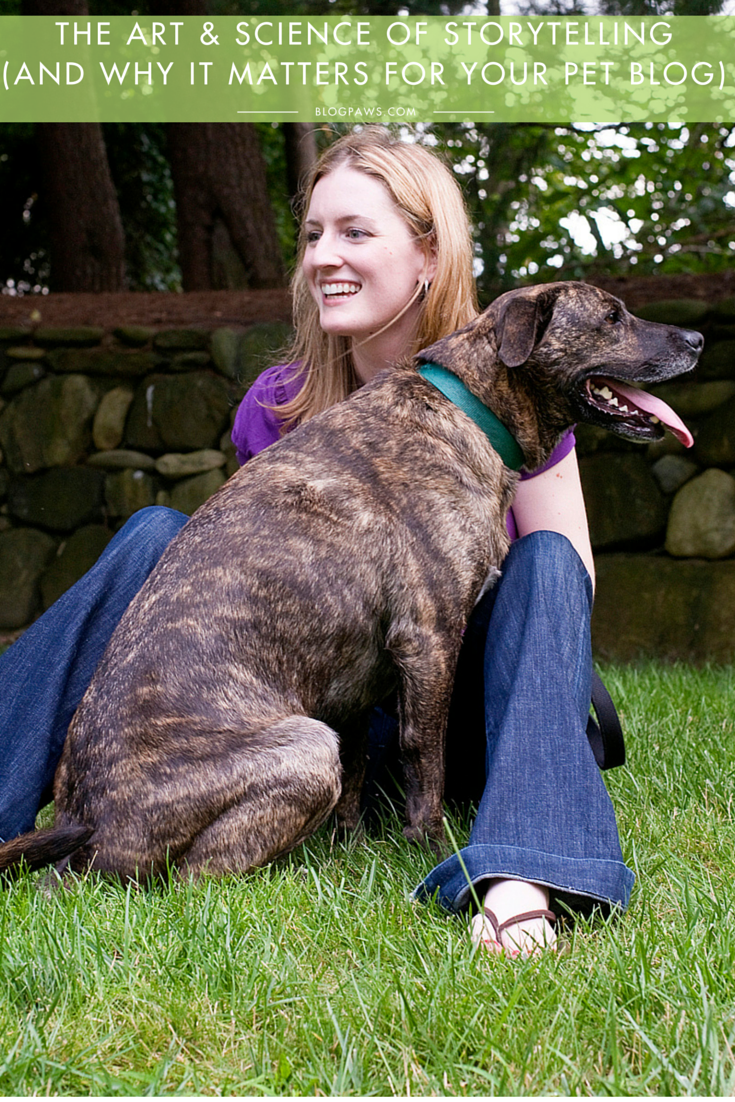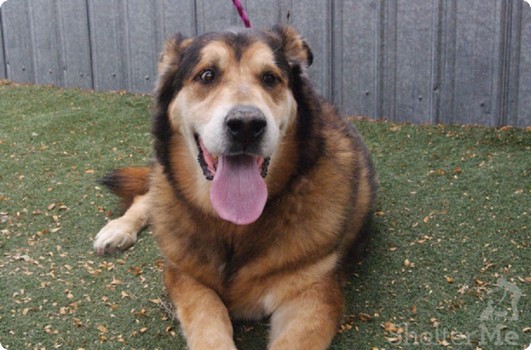The art and science of storytelling (and why it matters for your pet blog)
We got lost driving out to the no-kill shelter in northern Virginia. In fact, we almost gave up because, by the time we found our way around the horse farms and dirt roads to the right gravel drive, we only had half an hour to meet dogs before the shelter closed for the night. As we spotted the turn, John and I agreed: We’d scope it out for a few minutes before they closed then come back next weekend.
As we walked up to the adoption office, we talked through our “dream dog” list: no puppies, a big dog, a male, good with kids and other dogs. We met the shelter volunteer and relayed the list to her. Moments later, we were walking a dog named Robby. He was sweet. Hit all the checkboxes. But there just wasn’t a connection. “You have to meet Emmett,” the volunteer said. We watched out the office window as she collected Emmett from his kennel. The volunteer pitched forward then lurched back as this thick, blocky, brindled pup dropped low to the ground and dragged the volunteer at top speed across the gravel drive. She struggled to hold onto the leash and shouted, “Woah, Emmett! Slow down!” He barreled into the office and jumped right in my lap. That instant, we knew: Emmett was our dog.
He came home a week later, and this summer we’ll celebrate his 13th birthday and his 10th anniversary as a part of our family.
(That, by the way, is us way back when!)
Let’s look at that tale another way:
We adopted Emmett in 2006 from a shelter in Virginia. It almost didn’t happen because we got lost and nearly gave up trying to find the shelter. But, we fell in love with him instantly, despite the fact that he wasn’t leash trained. We adopted him on the spot. He turns 13 this summer.
Quiz question: Which version of that story did you like better?
The first one, right? Both deliver the same information, but the first tells a story.
There’s an art to storytelling. You have to decide which details to include, where to start, how to end, which words to choose, whether you’ll include dialogue, and on and on. Every detail matters. Should I place a comma here to create a pause? Does the word “bark” sound better than “woof” in this spot? Would it be better to end on a cliffhanger or with resolution? It’s like a painter deciding where to place each brush stroke; you’re painting your picture with words.
The art develops with practice. The more you write, the better you get.
The science of storytelling, on the other hand, isn’t something you can learn. In fact, you don’t have to! It’s something you already know.
Turns out, our brains are hardwired for stories. In “The science behind storytelling,” we learn, “While facts and figures engage a small area of the brain, stories engage multiple brain regions that work together to build colorful, rich three-dimensional images and emotional responses. As we read stories we quickly begin to feel as if what’s happening out there is actually happening in here. Each sensory image, sound, texture, color, sensation and emotion provides a hook for our brain as the story draws us in and maintains our attention effortlessly. This is the power of a great story.”
To read more about the neuroscience of storytelling, check out this fascinating article, “The Science of Storytelling: What Listening to a Story Does to Our Brains.”
We’ve been talking this month about engagement, and why this matters, why storytelling for pet bloggers is so important is because stories get your readers to engage on a deep level. When you’re reading a story, you dig in. You tune out the world around you. You pay attention. When you’re reading bullet points, you skim and move on. Harness the power of stories on your blog to increase engagement with your readers. Here’s how:
Three tips on storytelling for pet bloggers:
Start in the middle.
Drop your reader right into the middle of the tale. Skip preambles and prologues to hook them right away. Even though my adoption story started with John and I making the list of qualities we hoped to find in a dog, then combing shelter websites and researching like crazy, I started out with us being lost on the way to the shelter because that make the reader wonder, “What’s going to happen? Do they get a dog?” The boring lead-up stuff is just that: boring. Start with action, and your readers will engage instantly with your post.
Follow a narrative arc.
Every story has to have a beginning, a middle, and an end to be complete. Sophisticated writers know that the beginning doesn’t have to be first. The arc doesn’t have to be chronological. The trick is learning how to pull your reader from one point to the next without breaking the spell. Things to avoid: unnecessary or extraneous asides, skipping important details, and posing questions that you never answer. Most of us feel confident swapping stories with friends. If you’re feeling stuck on how to craft your narrative, think about how you would tell the story to your best friend over a cup of coffee, and write it like that. Your voice will be authentic, and you’ll naturally follow an arc. Tip: You can even record yourself telling the story, and transcribe the tape as the first draft of your post.
Show, don’t tell.
This is my favorite writing tenet. It deserves its own post, but for today, let’s look at Emmett’s story as an example. It’s more interesting and engaging to show Emmett dragging that poor shelter volunteer across the parking lot than it is to say, “Emmett wasn’t leash trained.” Showing how something happened creates that third dimension that sucks a reader into the story. As you craft your post, examine each sentence and ask yourself: Am I telling my reader how this happened or am I showing? It isn’t always possible to paint every detail vividly, but where it’s possible, do.
I’d like to challenge you to test out a storytelling format for your next blog post. See how these skills translate into your post, and analyze how your readers engage. Look at metrics like the time they spent on that post and the types and quality of comments they leave. Please let me know how it goes! Leave a storytelling link in the comments so we can learn from each other and provide feedback (if desired) on your post.
And, in the meantime, if you have any questions about storytelling or how to apply these strategies, please leave them in the comments below.
Maggie Marton serves as the BlogPaws senior editor. When not hiking with her two pit mixes, Emmett and Cooper, or playing with Newt the Cat, Maggie writes about them (and the pet industry) at ohmydogblog.com and maggiemarton.com.






